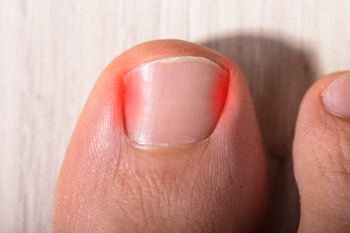 A noticeable sign that an ingrown toenail has developed is pain and redness at the edge of the skin next to the nail. It is defined as the nail growing into the surrounding skin, and if it becomes infected, there may be a pus or discharge. This condition may develop as a result of wearing shoes that do not fit correctly, or from an injury that has happened to the toe. Additionally, sporting activities that consist of abrupt stopping and repetitive pushing off the feet may also lead to an ingrown toenail forming. Some patients have found relief by soaking the affected foot in warm water and gently using a cotton swab to pull the skin away from the nail. This may not always be effective. If you have infected or recurring ingrown toenails, it is suggested that you seek the counsel of a podiatrist who can properly treat this ailment.
A noticeable sign that an ingrown toenail has developed is pain and redness at the edge of the skin next to the nail. It is defined as the nail growing into the surrounding skin, and if it becomes infected, there may be a pus or discharge. This condition may develop as a result of wearing shoes that do not fit correctly, or from an injury that has happened to the toe. Additionally, sporting activities that consist of abrupt stopping and repetitive pushing off the feet may also lead to an ingrown toenail forming. Some patients have found relief by soaking the affected foot in warm water and gently using a cotton swab to pull the skin away from the nail. This may not always be effective. If you have infected or recurring ingrown toenails, it is suggested that you seek the counsel of a podiatrist who can properly treat this ailment.
Ingrown toenails may initially present themselves as a minor discomfort, but they may progress into an infection in the skin without proper treatment. For more information about ingrown toenails, contact one of our podiatrists of Community Foot Specialists. Our doctors can provide the care you need to keep you pain-free and on your feet.
Ingrown Toenails
Ingrown toenails are caused when the corner or side of a toenail grows into the soft flesh surrounding it. They often result in redness, swelling, pain, and in some cases, infection. This condition typically affects the big toe and may recur if it is not treated properly.
Causes
- Improper toenail trimming
- Genetics
- Improper shoe fitting
- Injury from pedicures or nail picking
- Abnormal gait
- Poor hygiene
You are more likely to develop an ingrown toenail if you are obese, have diabetes, arthritis, or have any fungal infection in your nails. Additionally, people who have foot or toe deformities are at a higher risk of developing an ingrown toenail.
Symptoms
Some symptoms of ingrown toenails are redness, swelling, and pain. In rare cases, there may be a yellowish drainage coming from the nail.
Treatment
Ignoring an ingrown toenail can have serious complications. Infections of the nail border can progress to a deeper soft-tissue infection, which can then turn into a bone infection. You should always speak with your podiatrist if you suspect you have an ingrown toenail, especially if you have diabetes or poor circulation.
If you have any questions, please feel free to contact our offices located in Beavercreek, Dayton, and Vandalia, OH . We offer the newest diagnostic and treatment technologies for all your foot care needs.
